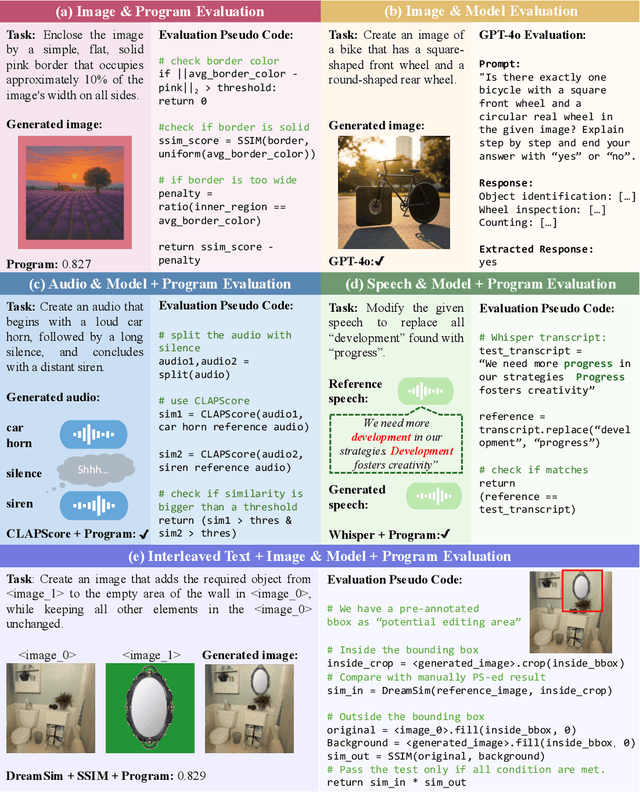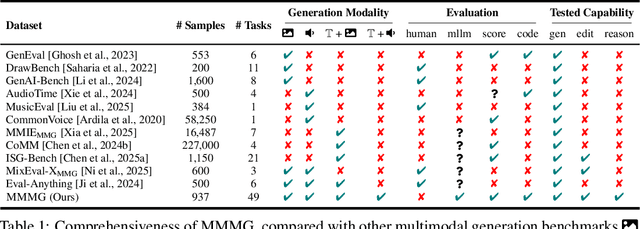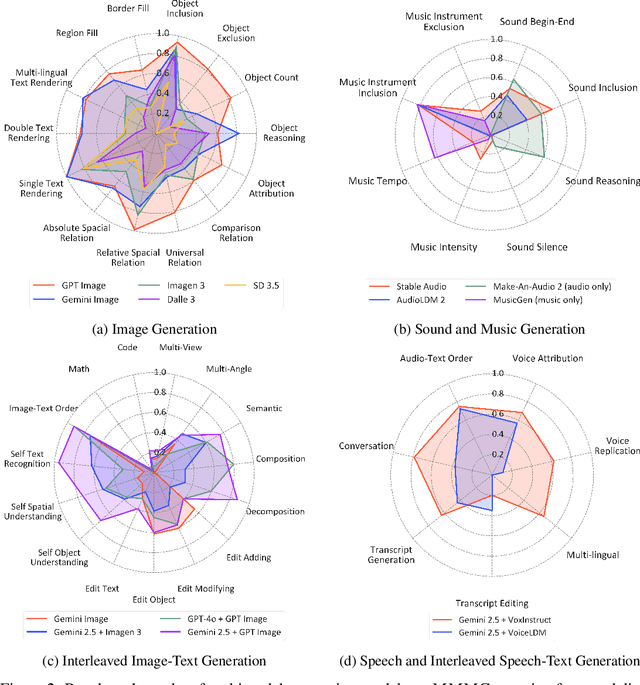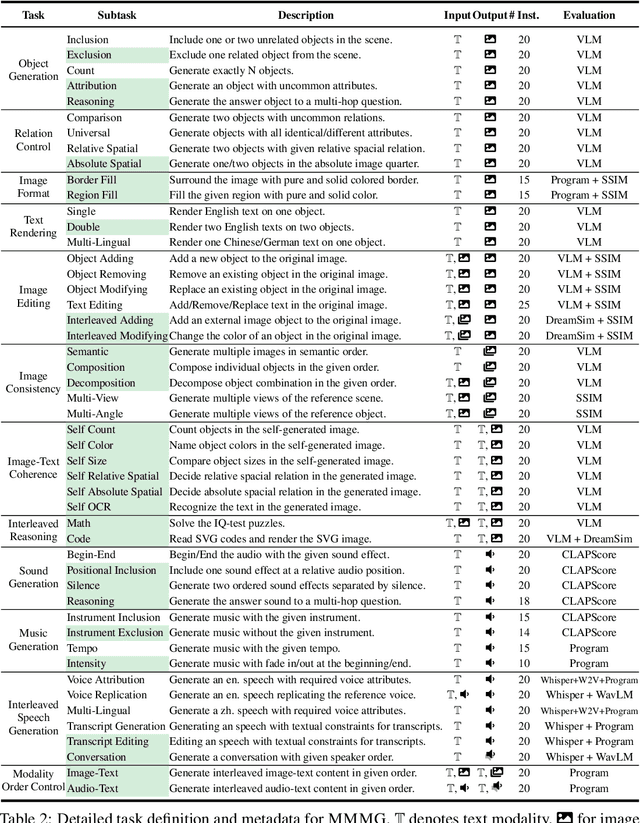Noah A. Smith
Paul G. Allen School of Computer Science & Engineering, University of Washington, Allen Institute for Artificial Intelligence
Rewriting History: A Recipe for Interventional Analyses to Study Data Effects on Model Behavior
Oct 16, 2025Abstract:We present an experimental recipe for studying the relationship between training data and language model (LM) behavior. We outline steps for intervening on data batches -- i.e., ``rewriting history'' -- and then retraining model checkpoints over that data to test hypotheses relating data to behavior. Our recipe breaks down such an intervention into stages that include selecting evaluation items from a benchmark that measures model behavior, matching relevant documents to those items, and modifying those documents before retraining and measuring the effects. We demonstrate the utility of our recipe through case studies on factual knowledge acquisition in LMs, using both cooccurrence statistics and information retrieval methods to identify documents that might contribute to knowledge learning. Our results supplement past observational analyses that link cooccurrence to model behavior, while demonstrating that extant methods for identifying relevant training documents do not fully explain an LM's ability to correctly answer knowledge questions. Overall, we outline a recipe that researchers can follow to test further hypotheses about how training data affects model behavior. Our code is made publicly available to promote future work.
Signal and Noise: A Framework for Reducing Uncertainty in Language Model Evaluation
Aug 18, 2025Abstract:Developing large language models is expensive and involves making decisions with small experiments, typically by evaluating on large, multi-task evaluation suites. In this work, we analyze specific properties which make a benchmark more reliable for such decisions, and interventions to design higher-quality evaluation benchmarks. We introduce two key metrics that show differences in current benchmarks: signal, a benchmark's ability to separate better models from worse models, and noise, a benchmark's sensitivity to random variability between training steps. We demonstrate that benchmarks with a better signal-to-noise ratio are more reliable when making decisions at small scale, and those with less noise have lower scaling law prediction error. These results suggest that improving signal or noise will lead to more useful benchmarks, so we introduce three interventions designed to directly affect signal or noise. For example, we propose that switching to a metric that has better signal and noise (e.g., perplexity rather than accuracy) leads to better reliability and improved scaling law error. We also find that filtering noisy subtasks, to improve an aggregate signal-to-noise ratio, leads to more reliable multi-task evaluations. We also find that averaging the output of a model's intermediate checkpoints to reduce noise leads to consistent improvements. We conclude by recommending that those creating new benchmarks, or selecting which existing benchmarks to use, aim for high signal and low noise. We use 30 benchmarks for these experiments, and 375 open-weight language models from 60M to 32B parameters, resulting in a new, publicly available dataset of 900K evaluation benchmark results, totaling 200M instances.
FlexOlmo: Open Language Models for Flexible Data Use
Jul 09, 2025Abstract:We introduce FlexOlmo, a new class of language models (LMs) that supports (1) distributed training without data sharing, where different model parameters are independently trained on closed datasets, and (2) data-flexible inference, where these parameters along with their associated data can be flexibly included or excluded from model inferences with no further training. FlexOlmo employs a mixture-of-experts (MoE) architecture where each expert is trained independently on closed datasets and later integrated through a new domain-informed routing without any joint training. FlexOlmo is trained on FlexMix, a corpus we curate comprising publicly available datasets alongside seven domain-specific sets, representing realistic approximations of closed sets. We evaluate models with up to 37 billion parameters (20 billion active) on 31 diverse downstream tasks. We show that a general expert trained on public data can be effectively combined with independently trained experts from other data owners, leading to an average 41% relative improvement while allowing users to opt out of certain data based on data licensing or permission requirements. Our approach also outperforms prior model merging methods by 10.1% on average and surpasses the standard MoE trained without data restrictions using the same training FLOPs. Altogether, this research presents a solution for both data owners and researchers in regulated industries with sensitive or protected data. FlexOlmo enables benefiting from closed data while respecting data owners' preferences by keeping their data local and supporting fine-grained control of data access during inference.
LEGATO: Large-scale End-to-end Generalizable Approach to Typeset OMR
Jun 23, 2025Abstract:We propose Legato, a new end-to-end transformer model for optical music recognition (OMR). Legato is the first large-scale pretrained OMR model capable of recognizing full-page or multi-page typeset music scores and the first to generate documents in ABC notation, a concise, human-readable format for symbolic music. Bringing together a pretrained vision encoder with an ABC decoder trained on a dataset of more than 214K images, our model exhibits the strong ability to generalize across various typeset scores. We conduct experiments on a range of datasets and demonstrate that our model achieves state-of-the-art performance. Given the lack of a standardized evaluation for end-to-end OMR, we comprehensively compare our model against the previous state of the art using a diverse set of metrics.
Broken Tokens? Your Language Model can Secretly Handle Non-Canonical Tokenizations
Jun 23, 2025Abstract:Modern tokenizers employ deterministic algorithms to map text into a single "canonical" token sequence, yet the same string can be encoded as many non-canonical tokenizations using the tokenizer vocabulary. In this work, we investigate the robustness of LMs to text encoded with non-canonical tokenizations entirely unseen during training. Surprisingly, when evaluated across 20 benchmarks, we find that instruction-tuned models retain up to 93.4% of their original performance when given a randomly sampled tokenization, and 90.8% with character-level tokenization. We see that overall stronger models tend to be more robust, and robustness diminishes as the tokenization departs farther from the canonical form. Motivated by these results, we then identify settings where non-canonical tokenization schemes can *improve* performance, finding that character-level segmentation improves string manipulation and code understanding tasks by up to +14%, and right-aligned digit grouping enhances large-number arithmetic by +33%. Finally, we investigate the source of this robustness, finding that it arises in the instruction-tuning phase. We show that while both base and post-trained models grasp the semantics of non-canonical tokenizations (perceiving them as containing misspellings), base models try to mimic the imagined mistakes and degenerate into nonsensical output, while post-trained models are committed to fluent responses. Overall, our findings suggest that models are less tied to their tokenizer than previously believed, and demonstrate the promise of intervening on tokenization at inference time to boost performance.
Sampling from Your Language Model One Byte at a Time
Jun 17, 2025Abstract:Tokenization is used almost universally by modern language models, enabling efficient text representation using multi-byte or multi-character tokens. However, prior work has shown that tokenization can introduce distortion into the model's generations. For example, users are often advised not to end their prompts with a space because it prevents the model from including the space as part of the next token. This Prompt Boundary Problem (PBP) also arises in languages such as Chinese and in code generation, where tokens often do not line up with syntactic boundaries. Additionally mismatching tokenizers often hinder model composition and interoperability. For example, it is not possible to directly ensemble models with different tokenizers due to their mismatching vocabularies. To address these issues, we present an inference-time method to convert any autoregressive LM with a BPE tokenizer into a character-level or byte-level LM, without changing its generative distribution at the text level. Our method efficient solves the PBP and is also able to unify the vocabularies of language models with different tokenizers, allowing one to ensemble LMs with different tokenizers at inference time as well as transfer the post-training from one model to another using proxy-tuning. We demonstrate in experiments that the ensemble and proxy-tuned models outperform their constituents on downstream evals.
Infini-gram mini: Exact n-gram Search at the Internet Scale with FM-Index
Jun 13, 2025Abstract:Language models are trained mainly on massive text data from the Internet, and it becomes increasingly important to understand this data source. Exact-match search engines enable searching in large text corpora -- counting string appearances and retrieving the enclosing documents -- yet the high storage overhead hinders their application on Internet-scale data. We present Infini-gram mini, an efficient and scalable system that can make petabyte-level text corpora searchable. Based on the FM-index data structure (Ferragina and Manzini, 2000), which simultaneously indexes and compresses text, our system creates indexes with size only 44% of the corpus. Infini-gram mini greatly improves upon the best existing implementation of FM-index in terms of indexing speed (18$\times$) and memory use during both indexing (3.2$\times$ reduction) and querying (down to a negligible amount). We index 46TB of Internet text in 50 days with a single 128-core CPU node (or 19 hours if using 75 such nodes). We show one important use case of Infini-gram mini in a large-scale analysis of benchmark contamination. We find several core LM evaluation benchmarks to be heavily contaminated in Internet crawls (up to 40% in SQuAD), which could lead to overestimating the capabilities of language models if trained on such data. We host a benchmark contamination bulletin to share the contamination rate of many core and community-contributed benchmarks. We also release a web interface and an API endpoint to serve general search queries on Infini-gram mini indexes.
MMMG: a Comprehensive and Reliable Evaluation Suite for Multitask Multimodal Generation
May 23, 2025



Abstract:Automatically evaluating multimodal generation presents a significant challenge, as automated metrics often struggle to align reliably with human evaluation, especially for complex tasks that involve multiple modalities. To address this, we present MMMG, a comprehensive and human-aligned benchmark for multimodal generation across 4 modality combinations (image, audio, interleaved text and image, interleaved text and audio), with a focus on tasks that present significant challenges for generation models, while still enabling reliable automatic evaluation through a combination of models and programs. MMMG encompasses 49 tasks (including 29 newly developed ones), each with a carefully designed evaluation pipeline, and 937 instructions to systematically assess reasoning, controllability, and other key capabilities of multimodal generation models. Extensive validation demonstrates that MMMG is highly aligned with human evaluation, achieving an average agreement of 94.3%. Benchmarking results on 24 multimodal generation models reveal that even though the state-of-the-art model, GPT Image, achieves 78.3% accuracy for image generation, it falls short on multimodal reasoning and interleaved generation. Furthermore, results suggest considerable headroom for improvement in audio generation, highlighting an important direction for future research.
PointArena: Probing Multimodal Grounding Through Language-Guided Pointing
May 15, 2025Abstract:Pointing serves as a fundamental and intuitive mechanism for grounding language within visual contexts, with applications spanning robotics, assistive technologies, and interactive AI systems. While recent multimodal models have started to support pointing capabilities, existing benchmarks typically focus only on referential object localization tasks. We introduce PointArena, a comprehensive platform for evaluating multimodal pointing across diverse reasoning scenarios. PointArena comprises three components: (1) Point-Bench, a curated dataset containing approximately 1,000 pointing tasks across five reasoning categories; (2) Point-Battle, an interactive, web-based arena facilitating blind, pairwise model comparisons, which has already gathered over 4,500 anonymized votes; and (3) Point-Act, a real-world robotic manipulation system allowing users to directly evaluate multimodal model pointing capabilities in practical settings. We conducted extensive evaluations of both state-of-the-art open-source and proprietary multimodal models. Results indicate that Molmo-72B consistently outperforms other models, though proprietary models increasingly demonstrate comparable performance. Additionally, we find that supervised training specifically targeting pointing tasks significantly enhances model performance. Across our multi-stage evaluation pipeline, we also observe strong correlations, underscoring the critical role of precise pointing capabilities in enabling multimodal models to effectively bridge abstract reasoning with concrete, real-world actions. Project page: https://pointarena.github.io/
BLAB: Brutally Long Audio Bench
May 05, 2025Abstract:Developing large audio language models (LMs) capable of understanding diverse spoken interactions is essential for accommodating the multimodal nature of human communication and can increase the accessibility of language technologies across different user populations. Recent work on audio LMs has primarily evaluated their performance on short audio segments, typically under 30 seconds, with limited exploration of long-form conversational speech segments that more closely reflect natural user interactions with these models. We introduce Brutally Long Audio Bench (BLAB), a challenging long-form audio benchmark that evaluates audio LMs on localization, duration estimation, emotion, and counting tasks using audio segments averaging 51 minutes in length. BLAB consists of 833+ hours of diverse, full-length audio clips, each paired with human-annotated, text-based natural language questions and answers. Our audio data were collected from permissively licensed sources and underwent a human-assisted filtering process to ensure task compliance. We evaluate six open-source and proprietary audio LMs on BLAB and find that all of them, including advanced models such as Gemini 2.0 Pro and GPT-4o, struggle with the tasks in BLAB. Our comprehensive analysis reveals key insights into the trade-offs between task difficulty and audio duration. In general, we find that audio LMs struggle with long-form speech, with performance declining as duration increases. They perform poorly on localization, temporal reasoning, counting, and struggle to understand non-phonemic information, relying more on prompts than audio content. BLAB serves as a challenging evaluation framework to develop audio LMs with robust long-form audio understanding capabilities.
 Add to Chrome
Add to Chrome Add to Firefox
Add to Firefox Add to Edge
Add to Edge